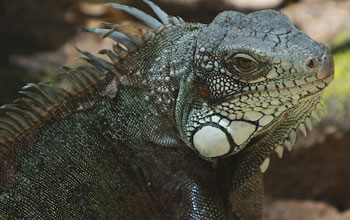Multimedia Gallery
Data Collection by Indigenous People (Image 5)
An iguana, one of over two-hundred animal species recorded by indigenous people hired as technicians to work on an animal population study in the Amazon basin region of Guyana. Researchers from Stanford University conducting the study found that native people were just as capable of systematically recording accurate data as trained researchers. (Date of Image: 2007-2010) [Image 5 of 7 related images. See Image 6.]
More about this Image
Researchers from Stanford University, working on an environmental study in the Rupununi region of Guyana, found that native people who participated in the collection of research data were just as capable of systematically recording accurate data as trained scientists. This finding disproves a theory held by some scientists that the cultural and educational differences between trained scientists and native peoples are too great for data collected by the latter to be reliable.
The purpose of the 5-year study, which covered a 48,000-square-kilometer area of the Amazon basin, was to determine the state of the vertebrate animal populations living there and how they are affected by human activities. The area, a forest-savanna ecosystem, is occupied by the Makushi and Wapishana peoples.
José Fragoso, an ecologist at Stanford and lead for the study, and colleagues knew it would be difficult to gather necessary data over such a large area alone--particularly in remote locations, so they enlisted some of the local population to help. "If I had tried to use only scientists, postdocs and graduate students to do the work, it would not have been accomplished," said Fragoso.
The researchers hired and trained more than 340 villagers as technicians, to collect field data in a consistent and systematic way. They were shown how to walk a transect through an area, record sightings and signs of animals, and note which plants the animals fed on, then mark their observations on a map.
To validate the accuracy of their data, the researchers had a different team of technicians or researchers walk a transect a second time, checking to be sure that the recorded data was correct and the animal sightings credible. Technicians also filled out monthly questionnaires about their work and performed statistical analyses for patterns of discrepancy in the data.
Fragoso found that data collected by technicians living in communities with strong leadership, and who were part of a larger indigenous organization such as an association of villages, were the most consistently accurate. Technicians from villages unaffiliated or loosely affiliated with such an association, where there was less oversight, fabricated data more commonly. Also, whether or not a technician was interested in the actual research as opposed to just a salary was a factor in accuracy.
In the end, Fragoso found that on average, the indigenous technicians were just as capable of systematically recording accurate data as the trained scientists. In fact, their ability to detect animals and their signs was probably even better.
"This is the first study at a really large scale that shows that consistently valid field data can be collected by trained, indigenous peoples and it can be done really well," Fragoso said. "We have measured the error and discovered that 28 percent of villages experienced some data fabrication. This originated from about 5 percent (18 out of 335) of technicians fabricating data, which may not be much different than what occurs in the community of scientists."
This research was supported by a Biocomplexity Coupled Human-Natural Systems grant from the National Science Foundation. The grant, titled "Biodiversity Dynamics and Land-Use Changes in the Amazon: Multi-Scale Interactions Between Ecological Systems and Resource-Use Decisions by Indigenous Peoples," awarded to Fragoso, the principal investigator. Further information about the study is available in the Stanford University news story, Can indigenous peoples be relied on to gather reliable environmental data that meet the standards of science?
Credit: Jose Manuel Fragoso
See other images like this on your iPhone or iPad download NSF Science Zone on the Apple App Store.
Special Restrictions: Permission to use this image has been granted by the owner for use in educational and news items only. The image should not be used in any manner that generates a financial return without consulting with the owner first. Contact José Fragoso of Stanford University at fragoso@stanford.edu for permission.
Images and other media in the National Science Foundation Multimedia Gallery are available for use in print and electronic material by NSF employees, members of the media, university staff, teachers and the general public. All media in the gallery are intended for personal, educational and nonprofit/non-commercial use only.
Images credited to the National Science Foundation, a federal agency, are in the public domain. The images were created by employees of the United States Government as part of their official duties or prepared by contractors as "works for hire" for NSF. You may freely use NSF-credited images and, at your discretion, credit NSF with a "Courtesy: National Science Foundation" notation.
Additional information about general usage can be found in Conditions.
Also Available:
Download the high-resolution JPG version of the image. (715 KB)
Use your mouse to right-click (Mac users may need to Ctrl-click) the link above and choose the option that will save the file or target to your computer.



